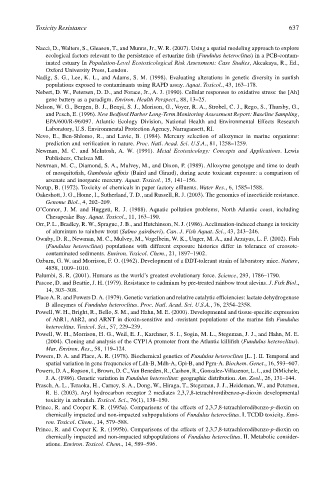Page 657 - The Toxicology of Fishes
P. 657
Toxicity Resistance 637
Nacci, D., Walters, S., Gleason, T., and Munns, Jr., W. R. (2007). Using a spatial modeling approach to explore
ecological factors relevant to the persistence of estuarine fish (Fundulus heteroclitus) in a PCB-contam-
inated estuary In Population-Level Ecotoxicological Risk Assessment: Case Studies, Akcakaya, R., Ed.,
Oxford University Press, London.
Nadig, S. G., Lee, K. L., and Adams, S. M. (1998). Evaluating alterations in genetic diversity in sunfish
populations exposed to contaminants using RAPD assay. Aquat. Toxicol., 43, 163–178.
Nebert, D. W., Petersen, D. D., and Forace, Jr., A. J. (1990). Cellular responses to oxidative stress: the [Ah]
gene battery as a paradigm. Environ. Health Perspect., 88, 13–25.
Nelson, W. G., Bergen, B. J., Benyi, S. J., Morison, G., Voyer, R. A., Strobel, C. J., Rego, S., Thursby, G.,
and Pesch, E. (1996). New Bedford Harbor Long-Term Monitoring Assessment Report: Baseline Sampling,
EPA/600/R-96/097. Atlantic Ecology Division, National Health and Environmental Effects Research
Laboratory, U.S. Environmental Protection Agency, Narragansett, RI.
Nevo, E., Ben-Shlomo, R., and Lavie, B. (1984). Mercury selection of allozymes in marine organisms:
prediction and verification in nature. Proc. Natl. Acad. Sci. U.S.A., 81, 1258–1259.
Newman, M. C. and McIntosh, A. W. (1991). Metal Ecotoxicology: Concepts and Applications. Lewis
Publishers, Chelsea MI.
Newman, M. C., Diamond, S. A., Mulvey, M., and Dixon, P. (1989). Allozyme genotype and time to death
of mosquitofish, Gambusia affinis (Baird and Girard), during acute toxicant exposure: a comparison of
arsenate and inorganic mercury. Aquat. Toxicol., 15, 141–156.
Norup, B. (1972). Toxicity of chemicals in paper factory effluents. Water Res., 6, 1585–1588.
Oakeshott, J. G., Home, I., Sutherland, T. D., and Russell, R. J. (2003). The genomics of insecticide resistance.
Genome Biol., 4, 202–209.
O’Connor, J. M. and Huggett, R. J. (1988). Aquatic pollution problems, North Atlantic coast, including
Chesapeake Bay. Aquat. Toxicol., 11, 163–190.
Orr, P. L., Bradley, R. W., Sprague, J. B., and Hutchinson, N. J. (1986). Acclimation-induced change in toxicity
of aluminum to rainbow trout (Salmo gairdneri). Can. J. Fish Aquat. Sci., 43, 243–246.
Ownby, D. R., Newman, M. C., Mulvey, M., Vogelbein, W. K., Unger, M. A., and Arzayus, L. F. (2002). Fish
(Fundulus heteroclitus) populations with different exposure histories differ in tolerance of creosote-
contaminated sediments. Environ. Toxicol. Chem., 21, 1897–1902.
Ozburn, G. W. and Morrison, F. O. (1962). Development of a DDT-tolerant strain of laboratory mice. Nature,
4858, 1009–1010.
Palumbi, S. R. (2001). Humans as the world’s greatest evolutionary force. Science, 293, 1786–1790.
Pascoe, D. and Beattie, J. H. (1979). Resistance to cadmium by pre-treated rainbow trout alevins. J. Fish Biol.,
14, 303–308.
Place A. R. and Powers D. A. (1979). Genetic variation and relative catalytic efficiencies: lactate dehydrogenase
B allozymes of Fundulus heteroclitus. Proc. Natl. Acad. Sci. U.S.A., 76, 2354–2358.
Powell, W. H., Bright, R., Bello, S. M., and Hahn, M. E. (2000). Developmental and tissue-specific expression
of AhR1, AhR2, and ARNT in dioxin-sensitive and -resistant populations of the marine fish Fundulus
heteroclitus. Toxicol. Sci., 57, 229–239.
Powell, W. H., Morrison, H. G., Weil, E. J., Karchner, S. I., Sogin, M. L., Stegeman, J. J., and Hahn, M. E.
(2004). Cloning and analysis of the CYP1A promoter from the Atlantic killifish (Fundulus heteroclitus).
Mar. Environ. Res., 58, 119–124.
Powers, D. A. and Place, A. R. (1978). Biochemical genetics of Fundulus heteroclitus [L. ]. II. Temporal and
spatial variation in gene frequencies of Ldh-B, Mdh-A, Gpi-B, and Pgm-A. Biochem. Genet., 16, 593–607.
Powers, D. A., Ropson, I., Brown, D. C., Van Beneden, R., Cashon, R., Gonzalez-Villasenor, L. I., and DiMichele,
J. A. (1986). Genetic variation in Fundulus heteroclitus: geographic distribution. Am. Zool., 26, 131–144.
Prasch, A. L., Teraoka, H., Carney, S. A., Dong, W., Hiraga, T., Stegeman, J. J., Heideman, W., and Peterson,
R. E. (2003). Aryl hydrocarbon receptor 2 mediates 2,3,7,8-tetrachlrordibenzo-p-dioxin developmental
toxicity in zebrafish. Toxicol. Sci., 76(1), 138–150.
Prince, R. and Cooper K. R. (1995a). Comparisons of the effects of 2,3,7,8-tetrachlorodibenzo-p-dioxin on
chemically impacted and non-impacted subpopulations of Fundulus heteroclitus. I. TCDD toxicity. Envi-
ron. Toxicol. Chem., 14, 579–588.
Prince, R. and Cooper K. R. (1995b). Comparisons of the effects of 2,3,7,8-tetrachlorodibenzo-p-dioxin on
chemically impacted and non-impacted subpopulations of Fundulus heteroclitus. II. Metabolic consider-
ations. Environ. Toxicol. Chem., 14, 589–596.

